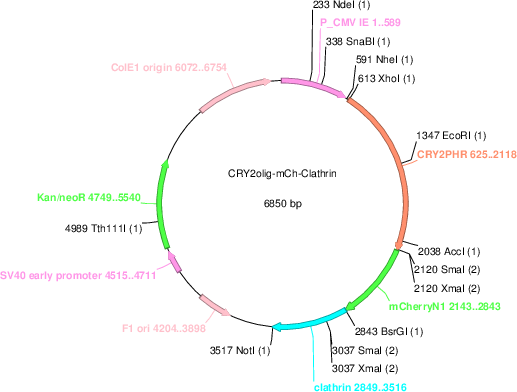CRY2olig-mCh-CLC
(Plasmid
#60035)
-
PurposeExpresses a fusion of CRY2olig (PHR, E490G) with mCherry and mouse clathrin light chain
-
Depositing Lab
-
Sequence Information
Ordering
| Item | Catalog # | Description | Quantity | Price (USD) | |
|---|---|---|---|---|---|
| Plasmid | 60035 | Standard format: Plasmid sent in bacteria as agar stab | 1 | $85 | |
Backbone
-
Vector backbonepmCherryN1
-
Backbone manufacturerClontech
- Backbone size w/o insert (bp) 4000
- Total vector size (bp) 6850
-
Vector typeMammalian Expression
Growth in Bacteria
-
Bacterial Resistance(s)Kanamycin, 50 μg/mL
-
Growth Temperature37°C
-
Growth Strain(s)DH5alpha
-
Copy numberHigh Copy
Gene/Insert
-
Gene/Insert nameCRY2-mCh-Clathrin Light Chain
-
Alt nameCRY2
-
Alt nameClathrin Light Chain
-
SpeciesM. musculus (mouse), A. thaliana (mustard weed)
-
Insert Size (bp)2892
-
MutationM354I, E490G CRY2, A9D*
-
Entrez GeneCRY2 (a.k.a. AT1G04400, AT-PHH1, ATCRY2, CRYPTOCHROME 2 APOPROTEIN, F19P19.14, F19P19_14, FHA, PHH1, cryptochrome 2)
- Promoter CMV
Cloning Information
- Cloning method Restriction Enzyme
- 5′ cloning site BsrGI (not destroyed)
- 3′ cloning site NotI (not destroyed)
- 5′ sequencing primer mCherry
- 3′ sequencing primer unknown (Common Sequencing Primers)
Terms and Licenses
-
Academic/Nonprofit Terms
-
Industry Terms
- Not Available to Industry
Trademarks:
- Zeocin® is an InvivoGen trademark.
Depositor Comments
*This plasmid contains clathrin light chain A, isoform a, with an A9D mutation relative to NM_001080384 (NP_001073853). This mutation, however, seems to be a natural variant, as it is present in other published sequences for mouse Clta
These plasmids were created by your colleagues. Please acknowledge the Principal Investigator, cite the article in which the plasmids were described, and include Addgene in the Materials and Methods of your future publications.
-
For your Materials & Methods section:
CRY2olig-mCh-CLC was a gift from Chandra Tucker (Addgene plasmid # 60035 ; http://n2t.net/addgene:60035 ; RRID:Addgene_60035) -
For your References section:
An optimized optogenetic clustering tool for probing protein interaction and function. Taslimi A, Vrana JD, Chen D, Borinskaya S, Mayer BJ, Kennedy MJ, Tucker CL. Nat Commun. 2014 Sep 18;5:4925. doi: 10.1038/ncomms5925. 10.1038/ncomms5925 PubMed 25233328





